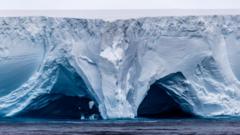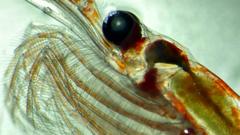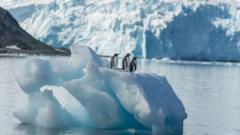The world's largest iceberg, named A23a, is dangerously close to the British territory of South Georgia, potentially endangering the local penguins and seals who call it home.
Giant Iceberg Approaches South Georgia: Wildlife at Risk

Giant Iceberg Approaches South Georgia: Wildlife at Risk
An impending collision with a massive iceberg poses a threat to vulnerable wildlife on South Georgia.
The iceberg, which has recently broken free from its previous confinement within a vortex in Antarctica, now drifts north towards the island, currently situated 173 miles away. In previous incidents, such icebergs have caused significant casualties among the local wildlife, blocking their access to essential feeding grounds for both birds and seals.
Sea captain Simon Wallace expressed grave concern over the situation in an interview with BBC News, stating, “Icebergs are inherently dangerous. I would be extraordinarily happy if it just completely missed us.” Scientists and sailors alike are actively tracking the movements of A23a as it drifts onward.
Initially calving from the Filchner Ice Shelf in 1986, A23a is gradually melting and losing size as it approaches the warmer waters of the northern Antarctic region. Once measuring an area of 3,900 square kilometers—roughly the size of Cornwall—satellite images now show a size decrease to around 3,500 square kilometers.
The potential for A23a to fracture into smaller, floating ice segments raises alarms reminiscent of past occurrences in 2004 when another iceberg, A38, resulted in the loss of penguin chicks and seal pups due to restricted access to feeding grounds.
Mark Belchier, a marine ecologist, explained the ongoing impacts: “South Georgia sits in iceberg alley so impacts are to be expected for both fisheries and wildlife, and both have a great capacity to adapt.”
The increasing presence of icebergs has transformed navigation for local fishermen and sailors. A recent close encounter with iceberg A76 in 2023 illustrated the challenges faced, with its enormous size altering operational safety measures significantly.
As climate change continues to transform Antarctica's landscape, more icebergs are expected to break away. While A23a’s origins predate significant warming trends, its emergence highlights a troubling environmental reality.
Nonetheless, A23a offers a unique research opportunity. A British Antarctic Survey team aboard the Sir David Attenborough vessel has been studying the environmental impacts of icebergs. PhD researcher Laura Taylor reported her exhilarating experience as she collected crucial water samples.
“The melting iceberg releases nutrients and chemicals into the ocean, impacting the carbon cycle,” explained Ms. Taylor. This could potentially enhance carbon storage in deeper ocean layers, providing a natural method of sequestering carbon dioxide emissions linked to climate change.
While the fate of A23a remains uncertain, its arrival will serve as a striking reminder of the impacts of climate variability on this remote ecosystem, as well as the urgency for wildlife preservation efforts.
Sea captain Simon Wallace expressed grave concern over the situation in an interview with BBC News, stating, “Icebergs are inherently dangerous. I would be extraordinarily happy if it just completely missed us.” Scientists and sailors alike are actively tracking the movements of A23a as it drifts onward.
Initially calving from the Filchner Ice Shelf in 1986, A23a is gradually melting and losing size as it approaches the warmer waters of the northern Antarctic region. Once measuring an area of 3,900 square kilometers—roughly the size of Cornwall—satellite images now show a size decrease to around 3,500 square kilometers.
The potential for A23a to fracture into smaller, floating ice segments raises alarms reminiscent of past occurrences in 2004 when another iceberg, A38, resulted in the loss of penguin chicks and seal pups due to restricted access to feeding grounds.
Mark Belchier, a marine ecologist, explained the ongoing impacts: “South Georgia sits in iceberg alley so impacts are to be expected for both fisheries and wildlife, and both have a great capacity to adapt.”
The increasing presence of icebergs has transformed navigation for local fishermen and sailors. A recent close encounter with iceberg A76 in 2023 illustrated the challenges faced, with its enormous size altering operational safety measures significantly.
As climate change continues to transform Antarctica's landscape, more icebergs are expected to break away. While A23a’s origins predate significant warming trends, its emergence highlights a troubling environmental reality.
Nonetheless, A23a offers a unique research opportunity. A British Antarctic Survey team aboard the Sir David Attenborough vessel has been studying the environmental impacts of icebergs. PhD researcher Laura Taylor reported her exhilarating experience as she collected crucial water samples.
“The melting iceberg releases nutrients and chemicals into the ocean, impacting the carbon cycle,” explained Ms. Taylor. This could potentially enhance carbon storage in deeper ocean layers, providing a natural method of sequestering carbon dioxide emissions linked to climate change.
While the fate of A23a remains uncertain, its arrival will serve as a striking reminder of the impacts of climate variability on this remote ecosystem, as well as the urgency for wildlife preservation efforts.






















